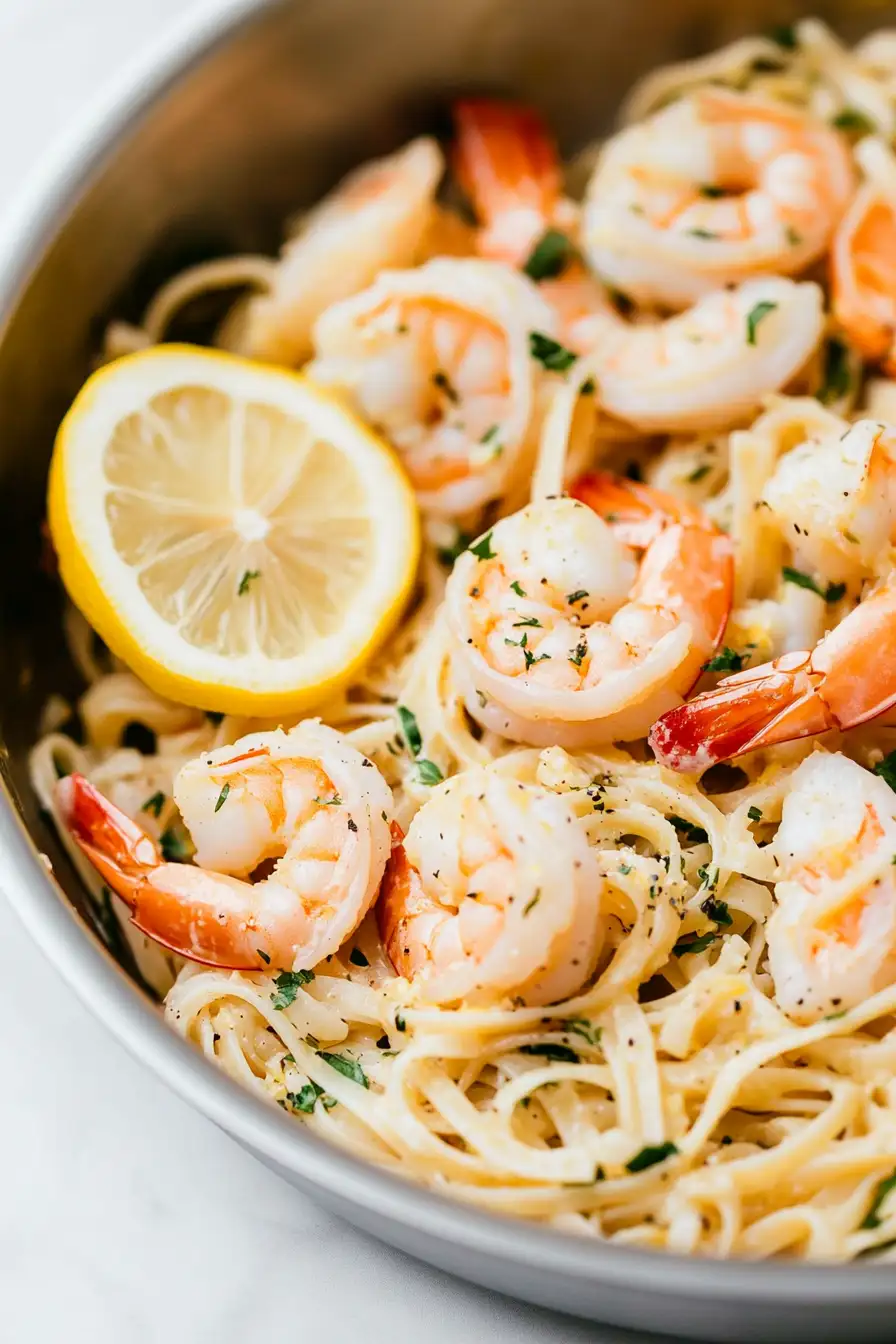I used to think shrimp scampi was something you only ordered at fancy Italian restaurants. Growing up, my mom stuck to basic pasta with marinara sauce, and anything involving seafood felt way too complicated for our kitchen.
Turns out, making shrimp scampi at home is actually pretty simple – and it’s way cheaper than the restaurant version. All you need are some good shrimp, pasta, garlic, and a few pantry staples. Once you get the hang of the timing (because no one likes overcooked shrimp), it’s the kind of dinner you can throw together without even thinking about it.

Why You’ll Love This Shrimp Scampi
- Quick preparation – This restaurant-worthy meal comes together in just 25-35 minutes, perfect for those busy weeknights when you want something special but don’t have hours to spend in the kitchen.
- Simple ingredients – You’ll only need a handful of basic ingredients that are easy to find at any grocery store – pasta, shrimp, garlic, and lemon are the stars here.
- Fresh and light – The combination of bright lemon, fresh parsley, and garlic creates a light yet satisfying sauce that lets the shrimp shine without feeling heavy.
- Impressive results – While it’s surprisingly easy to make, this dish looks and tastes like something from an Italian restaurant, making it perfect for both casual dinners and special occasions.
What Kind of Shrimp Should I Use?
For shrimp scampi, you’ll want to look for large shrimp (sometimes labeled as 16/20 or 21/25 per pound) – they’re the perfect size to stand up to the pasta without getting lost in the dish. Fresh shrimp is great if you can find it, but frozen shrimp is actually a smart choice since most “fresh” shrimp at the seafood counter was previously frozen anyway. When shopping, pick shrimp that’s already peeled and deveined to save prep time, but make sure to keep the tails on as they add extra flavor to the sauce. If you’re using frozen shrimp, thaw them overnight in the fridge or in a bowl of cold water for about 15 minutes, and pat them dry before cooking to help them get a nice sear.

Options for Substitutions
This classic pasta dish is pretty adaptable! Here are some helpful swaps you can try:
- Linguine: While linguine is traditional, you can easily use spaghetti, fettuccine, or angel hair pasta. Gluten-free pasta works too, just be sure to cook it al dente.
- Shrimp: If you can’t find fresh shrimp, frozen works just fine – just thaw them completely first. In a pinch, you could use scallops or even chunks of firm white fish, though cooking times might need adjusting.
- Butter and olive oil: You can use all butter or all olive oil instead of the combination. If using only olive oil, add an extra tablespoon to make up for the richness.
- Fresh parsley: No fresh parsley? Use 2 tablespoons dried parsley, or try fresh basil or cilantro for a different twist.
- Fresh lemons: Bottled lemon juice can work in a pinch, but reduce the amount to 3 tablespoons since it’s more concentrated. For zest, you can skip it if using bottled juice, though you’ll miss some flavor.
- Parmesan cheese: Romano or Pecorino cheese make good substitutes. Pre-grated cheese will work too, though fresh-grated melts better and has more flavor.
Watch Out for These Mistakes While Cooking
The biggest mistake when making shrimp scampi is overcooking the shrimp, which can turn them from perfectly tender to tough and rubbery in just a matter of seconds – they only need 2-3 minutes per side until they turn pink and curl into a loose ‘C’ shape.
Another common error is adding the garlic too early in the cooking process, where it can quickly burn and become bitter – instead, add it just before the shrimp for the best flavor and aroma.
The pasta water is liquid gold for this dish, so don’t forget to save about 1 cup before draining – this starchy water helps create a silky sauce that perfectly coats each strand of linguine.
For the best results, toss your pasta directly in the pan with the shrimp and sauce rather than serving the sauce on top, and don’t skip the fresh parsley and lemon zest at the end – they’re not just garnish but essential flavor components that make the dish come alive.

What to Serve With Shrimp Scampi Linguine?
This lemony, garlicky pasta dish pairs perfectly with light sides that won’t overshadow its fresh flavors. A simple arugula salad with a light lemon vinaigrette makes an excellent companion, cutting through the richness of the buttery sauce. If you’re looking for something warm, roasted asparagus or broccolini seasoned with just olive oil, salt, and pepper works beautifully alongside the pasta. For a complete Italian-inspired meal, serve some warm crusty bread on the side – it’s perfect for soaking up any extra scampi sauce left on your plate (trust me, you won’t want to waste a drop!).
Storage Instructions
Keep Fresh: Pop your leftover shrimp scampi linguine in an airtight container and place it in the fridge. It’ll stay good for up to 3 days, though the pasta might absorb some of the sauce. I like to add a tiny drizzle of olive oil before storing to keep the noodles from sticking together.
Make Ahead: If you want to prep ahead, cook the pasta al dente and toss it with a bit of olive oil. Store the pasta and shrimp sauce separately in the fridge. When you’re ready to eat, just combine them in a pan and warm everything up together – it’ll taste just like freshly made!
Warm Up: To bring your leftovers back to life, warm them gently in a pan over medium-low heat with a splash of water or chicken broth to loosen up the sauce. You can also use the microwave, but be careful not to overcook the shrimp – heat in 30-second intervals, stirring in between. A fresh sprinkle of parmesan and parsley makes it taste good as new!
| Preparation Time | 10-15 minutes |
| Cooking Time | 15-20 minutes |
| Total Time | 25-35 minutes |
| Level of Difficulty | Easy |
Estimated Nutrition
Estimated nutrition for the whole recipe (without optional ingredients):
- Calories: 1800-2000
- Protein: 90-100 g
- Fat: 100-110 g
- Carbohydrates: 150-160 g
Ingredients
For the linguine:
- 1 lb linguine
For the shrimp and sauce:
- 1/2 lemon (thinly sliced, for garnish)
- 3 tbsp olive oil
- 1/4 cup lemon juice
- 1 lb large shrimp (peeled and deveined)
- 5 garlic cloves (freshly minced for best flavor)
- kosher salt
- black pepper (freshly ground preferred for more flavor)
- zest from 1/2 large lemon
- crushed red pepper flakes
- 4 tbsp unsalted butter (I like Kerrygold unsalted butter for this)
- 1/2 cup fresh parsley (finely chopped, about 1/4-inch pieces)
For the garnish:
- 1/2 cup fresh grated Parmesan cheese (recommended for best flavor)
Step 1: Cook the Linguine
Bring a large pot of water to a boil.
Once boiling, add a little bit of oil and salt to the water.
Add the linguine and cook according to the package instructions until al dente.
While the pasta is cooking, prepare the shrimp and sauce.
Step 2: Prep the Shrimp
Season the shrimp with salt and pepper and set them aside.
This will allow the flavors to infuse while you prepare the garlic and oil mixture.
Step 3: Sauté Garlic and Shrimp
Add the butter and olive oil to an extra-large skillet over medium-low heat.
Once the butter has melted, add the garlic and sauté for 1 minute, being careful not to burn it.
Next, add the seasoned shrimp to the skillet.
Sauté the shrimp until they turn pink, about 4-5 minutes, tossing often to ensure even cooking.
Step 4: Add Flavor Enhancements
Remove the skillet from heat and incorporate the parsley, lemon zest, lemon juice, lemon slices, and red pepper flakes.
Toss to combine all ingredients.
Taste and season with additional salt and pepper, if needed.
Step 5: Combine Linguine with Shrimp and Sauce
Once the linguine is cooked, drain the water and transfer the noodles to the sauté pan with the shrimp and sauce.
Sprinkle fresh Parmesan cheese over the top.
Gently toss everything to thoroughly combine.
Serve warm and enjoy your delicious shrimp and linguine!

